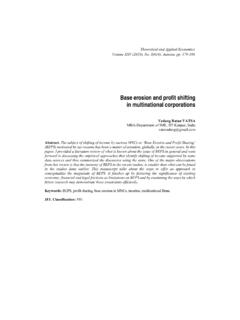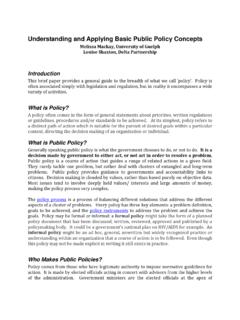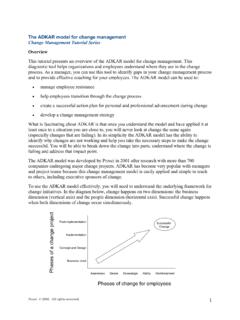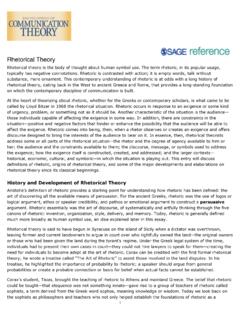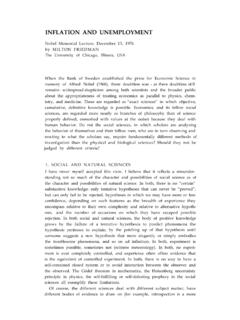Transcription of Manipulative marketing: persuasion and manipulation of …
1 Manipulative marketing: persuasion and manipulation of the consumer through advertising Victor DANCIU Bucharest University of Economic Studies Abstract. The manipulation through advertising became an issue the consumers are facing on almost a regular basis. This practice move away the mission of marketing that of meeting the needs of customers and widens the asymmetries of power between the company and the consumer. Many of Manipulative advertisements are difficult to prove because of their controversial nature and content. This paper is about how the companies use the stimuli, the techniques and the mechanisms of advertising to manipulate the consumers. At the same time, it advances some suggestions about the diminishing of the Manipulative practices.
2 The effectiveness of these solutions will depend on the observance of some principles by the companies which advertise in areas where they and the consumers can find mutual goals and interests. Keywords: Manipulative advertising, Manipulative techniques, deceptive advertising, fallacious arguments, emotive persuasion , conscious consumer, conscious advertising. JEL Classification: M31, M37, M38. REL Classification: 14G. Theoretical and Applied Economics Volume XXI (2014), No. 2(591), pp. 19-34 Victor Danciu 20 1. Introduction: Stimuli of consumer manipulation through advertising The marketing is directing the business according to the point of view of the customer seems the marketing concept which best throws a light upon the market goal of the company.
3 In other words, the company should focus permanently on the consumers needs. The companies have their interests and objectives which many times are far from aligning with what the consumers need, and, quite often, don t hesitate to make up marketing solutions which misconduct or deceive the consumers, in order to achieve them. The most appropriate area of marketing for such practices is the communication. The marketing communication is a mix of tools for promoting the products by transmitting particular messages to the consumers aiming at persuade them to purchasing those products. The advertising is the element of communication mix which offers all needed means, tools and ways of action for promoting the marketing objectives of the company.
4 If a company deliberately decides to manipulating the consumer through advertising, in order to achieve its objectives, it could take into account some stimuli or preises which will ease the concrete advertising activities. A first stimulus consists in the good knowledge of consumer s purchasing behavior and the capability of the company to influence it. The advertising focus on the process and mechanism the customer uses for making the purchasing decision. This purchasing decision process has the meeting of the consumers needs as unique motivation. As Maslow has established, the consumers have three categories of needs. The first category includes the utilitarian needs such as the need of shelter, nourishment, and security.
5 At the next level are the social needs like to be accepted by others. At the top, we can find the psychological needs which make the consumer behaving in certain ways that are consistent with his self image and that enhance his self image to others. The functions of advertising could be linked to different mixes of needs. There are many and various functions the advertising could fulfil such as identification of the product, its differentiation from others, consumer s information which induces the consumer to try new products, suggests the reuse, builds brand value, preference and loyalty (Danciu, 2009; Fowles; ). All these functions of advertising prove useful to influence the purchasing decision process of the consumer behavior if the advertising succeeds to persuade the consumer to prefer, purchase and use the product and to become loyal to it.
6 Another strong stimulus for consumer manipulation through advertising is the capability and the extent of alteration of the mechanism of advertising which aims to persuade the consumer. The persuasive advertising could be divided into two Manipulative marketing: persuasion and manipulation of the consumer through advertising 21types which are non- Manipulative and Manipulative advertising. The non- Manipulative persuasion through advertising consists in simply presenting the product or service, in the best possible light. The advertiser doesn t need to lie, omit details or intimidate the consumer. This type of advertising is truthful, that is the facts presented are real, the information is giving in a clear, logical manner, in order to convince by informing (Grover, 2011).
7 The informative and persuasion functions of advertising are based on facts and emotional arguments. The informative advertising gives factual information to the consumer, while the emotional advertising consists in an emotional game which has as goal to favorable influence the decision of the consumer. There are many situations when combined alternatives are needed and they consist in various emotional games which are used as arguments for a certain way of acting on target-groups and individual consumers. Every time when these advertising efforts are focused on getting the consumers to do what the advertiser wants through subversive manners that lack the truth, we can say this is manipulation .
8 Where the advertiser try to persuade the consumer by giving him facts for example, if it is a manipulator may make up or imply facts. The non-ethical behavior of the advertisers is also a stimulus for manipulation through advertising. The issue of Manipulative persuasion in advertising brings out the discussion on the role of ethics. The ethics of marketing has in view to what extent the marketing behavior, decisions and practices fit the rules and principles of good conduct. The advertising practices must have a set of ethical principles that could help the managers to evaluate the moral importance of each action and to decide how far they could go, in order to stay just on line of ethics.
9 The research of the subject highlights three dominant principles of ethics in advertising which obey the law, act in your self-interest and comply with the ethics (Craig Smith, 2000; Danciu, 2009; Gray, 2011). It is not disputed that the advertisers have as obligation to obey the law and to act in their enlightened self-interest. However, many of the present practices of advertising show that are an increasing number of cases when there is no alignment of the marketer s self-interest with customers interest. There are numerous situations when the companies try to induce the customers the feeling that they maximize the customer s satisfaction through Manipulative advertisements.
10 All these arguments support the idea that the law and the self-interest are not sufficient guidelines for good conduct in marketing advertising. The advertisers must also be guided by ethics, especially by normative marketing ethics that is prescriptive, identifying moral principles and methods of moral reasoning that justify rules and judgments of what is right and wrong (Craig Smith, 2000). Victor Danciu 22 2. The Manipulative advertising inside the spectrum of the persuasive advertising In order to show how the persuasive advertising could become a Manipulative one, we should answer to the question of what is the range of persuasion which goes in advertising. Since the persuasion is both rational and emotional, the manipulation area that can be utilized in advertising may emerge from the spectrum of persuasion conceived by Creighton ( ).


